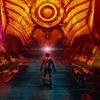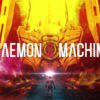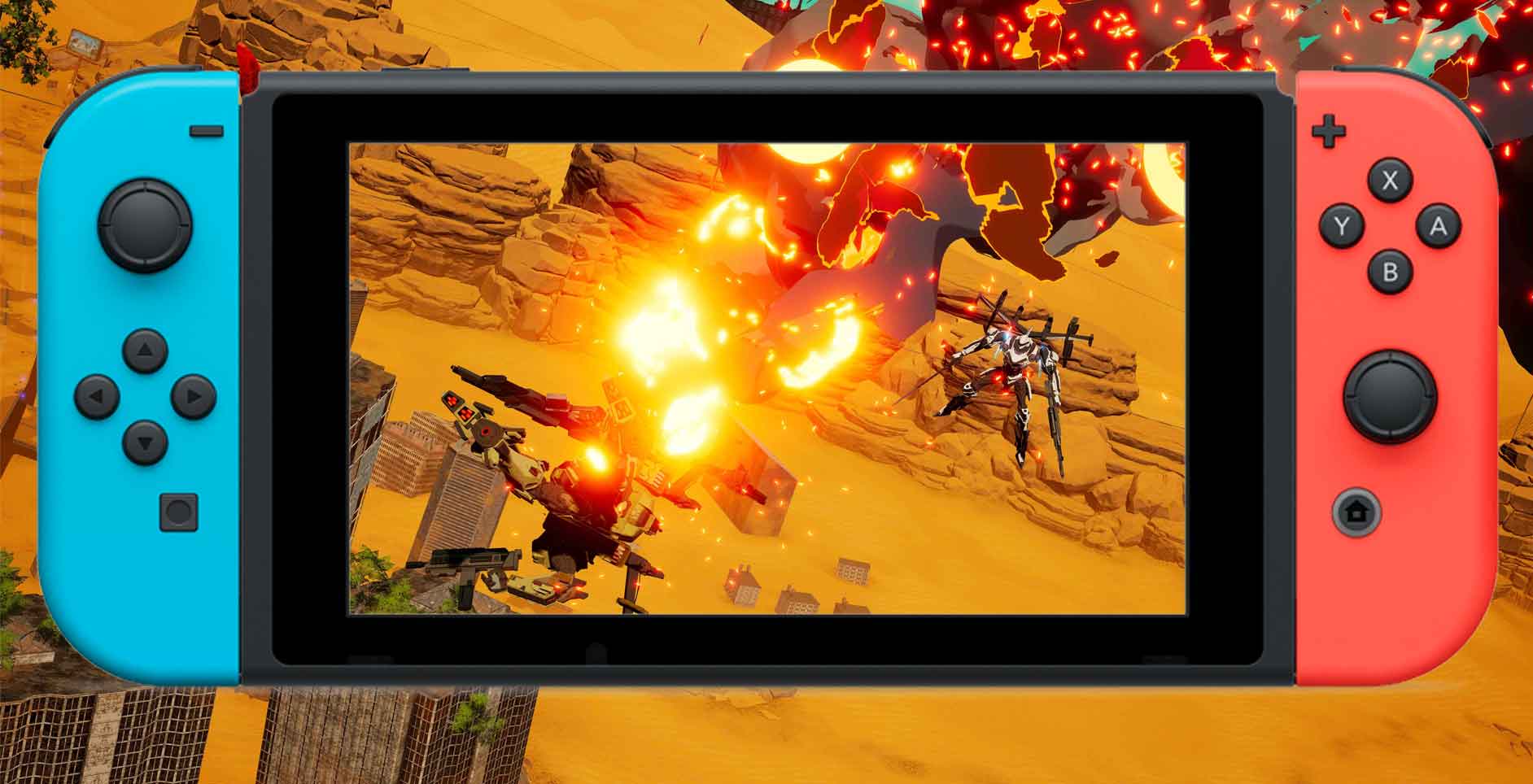During Gamescom 2018 I got to sit down with the Producer of upcoming Switch exclusive Daemon X Machina, Kenichiro Tsukuda, and talk all about the game and what players can expect from it when it launches in early 2019.
We discussed the game’s narrative, gameplay, sources of inspirations, and some nitty gritty detail on what you can expect from the upcoming mech title!
Q: The team just showed off a new trailer at Gamescom mentioning ‘The Awakening’. I’d love to hear more about that, and what that potentially means in terms of narrative?
So that word, the awakening, in a general sense it refers to everything that is happening in the world of Daemon X Machina. Unfortunately, as you probably guessed, I can’t say much more than that because then I’d have to tell you the whole story! We want to keep fans excited so we don’t want to reveal too much at the moment.
We hope, though, that you got the sense that in the world of Daemon X Machina there’s this conflict happening between humans and what are called the AI — the enemies. And we hope that trailer gave you the sense that some dramatic things are going to be happening in that conflict.
Q: Can you discuss how you and the team came up with the ideas behind Daemon X Machina?
So I came up with the overall concept of the game. I had the basic idea of creating the design document which I shared with the team, and then it was a big process of brainstorming and discussing things together from there.
We really thought about what kind of experience we want to give to players — how do we want them to actually feel when they’re playing the game, and what kind of scenes, what kind of story we can include in the game. We basically started a big process of discussing it together as a team and that’s how the development came to life.
We thought, ‘if we just kind of talk about it we’d get to a point where we’d lose sight of the core concept’ so pretty early on we wanted to get a prototype up and start playing it as well.
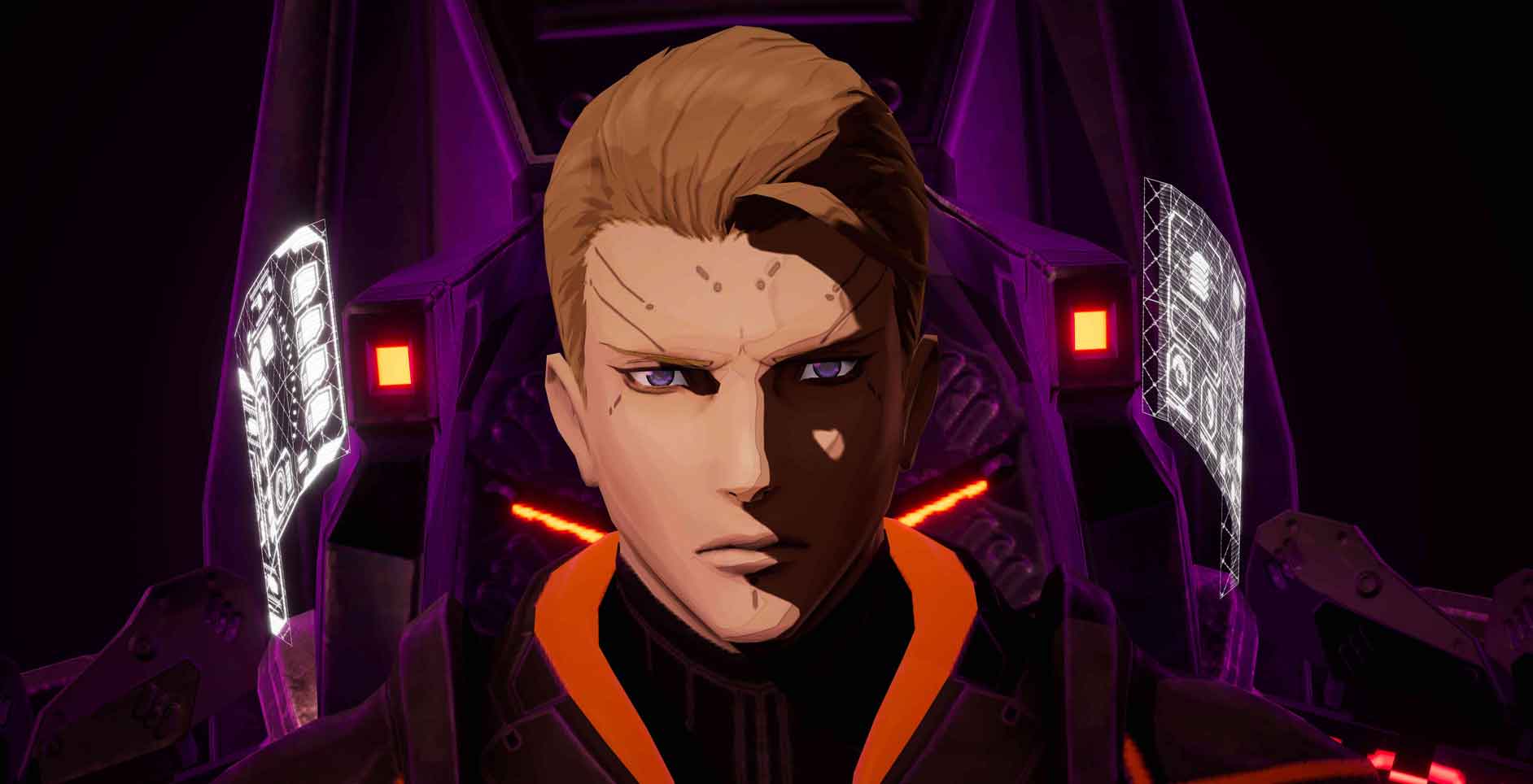
Q: Tsukuda-san, you’ve worked on previous games like the Armoured Core series, can you talk about the inspirations you’ve drawn on coming into Daemon X Machina?
As you’ve said I have worked on mech games in the past, and this time it was really about how I could make a mech game that people could really fall in love with. A lot of mech games seem to basically be all about the fighting — it’s just fighting, fighting, fighting. And I thought about how I could change that for Daemon X Machina.
In this game you have a player character that you create who’s your avatar — we’ve made that quite an important part of the game. And so you can upgrade your avatar, also known as an Outer, as you make your way through Daemon X Machina, and give them new skills and new abilities. Then, when the Outer gets inside his mech and is piloting a mech, those upgrades, skills, and abilities of the Outer actually transfer to the mech as well. What we wanted with that was to give the player that sense of a strong connection with the avatar, and the player themselves having a sense of growing and becoming more powerful throughout the game, with that transferring over to the mech as well.
One of the reasons I think people play games is this almost escapist thing of ‘wouldn’t it be cool if I actually were a mech’ or ‘wouldn’t it be cool if I could fight like this and become more powerful.’ So in that sense, with Daemon X Machina we wanted to create the strongest sense of immersion that we could for the player — to really get into that world and really experience these things as directly as possible.
Q: Was the connection between the Outer and the mech an early design concept, and was it always set to be such a fundamental part of the game?
So it wasn’t right from the start. It was something, as we developed the game, we realised would be really cool to do — to be able to upgrade the Outer and their connection to the mech.
The idea we had at the very start was almost the reverse. Where as you fight, the mech would get destroyed and only then would the person inside become visible and, even with NPC characters as well, you could see who was inside the mech. You wouldn’t see it at the start, but eventually, you’d see who’s inside each mech — maybe it’s a man, maybe it’s a woman, maybe it’s a young person, maybe they’re old… and as you met these NPC’s throughout you would have been able to choose the ones you liked to become your allies.
An element of that interaction is still in the game now, but we quickly realised that starting off inside the mech [wasn’t going to work] — we wanted the avatar as a central part of the game, and thereby build this strong player connection with the avatar, also avoiding being a game where you’re just running around shooting a load of guns.
As an action game, I think it has to be interesting as well. And with the way we’ve done it — with the avatar character becoming stronger and having that connection to the mech where the mech becomes stronger as well — it’ll resonate with people who wouldn’t regularly play this kind of game or play action games in general. I think it will make it accessible for a broad audience.
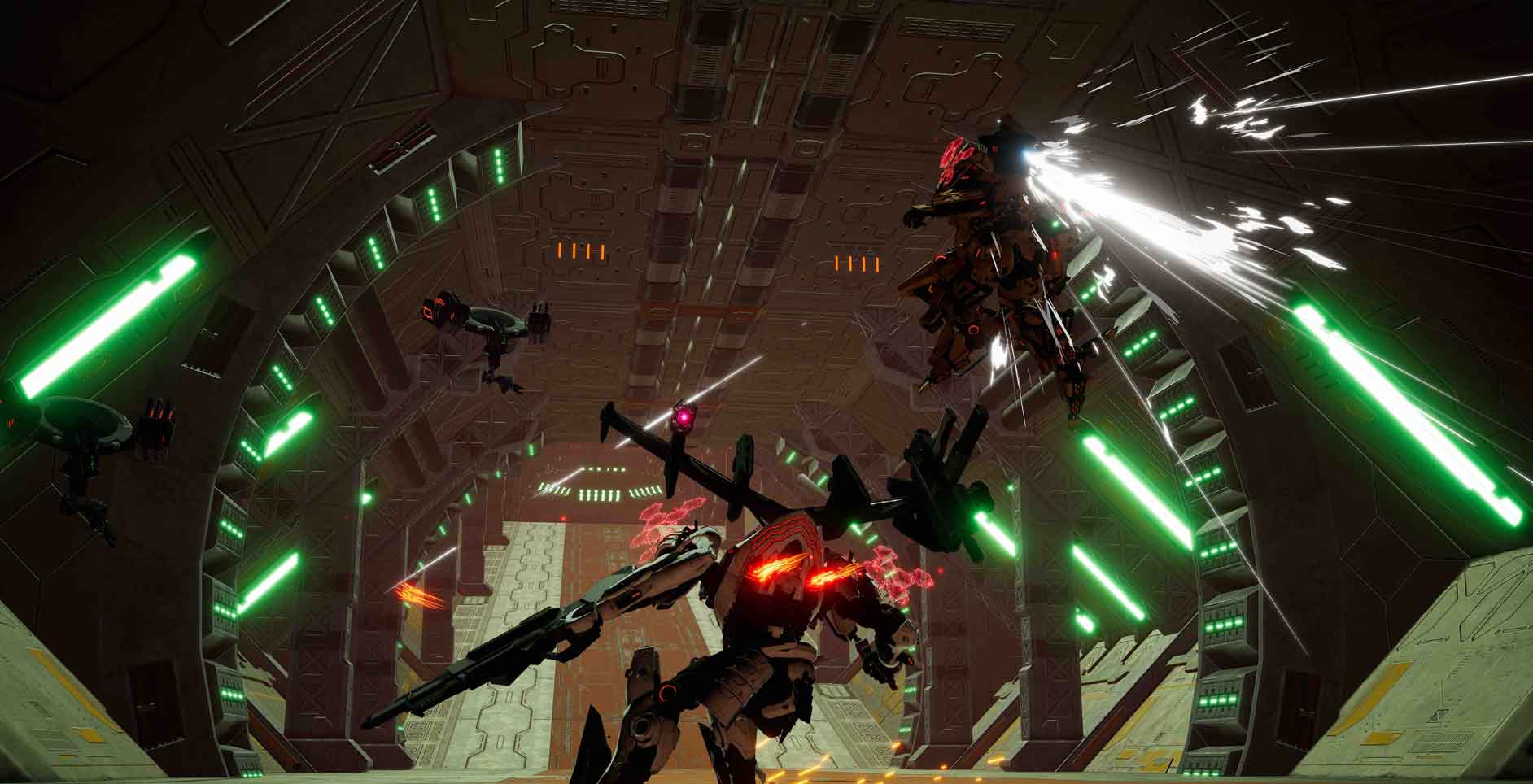
Q: Another part of the game I picked up on was the fact you can pick up weapons in the battlefield and put them onto your mech. How integral is that to the gameplay experience in Daemon X Machina?
So there are lots of games out there where you equip yourself for battle and then you go into battle. We had the idea where you can take weapons from fallen enemies, which will allow you to change your strategy on the fly. And so it makes it more interesting, where you have a situation where you may have an enemy that you can’t defeat and so maybe if you go somewhere else and defeat an enemy, take their weapon, and then go back to the enemy giving you trouble then maybe you’ll be able to tackle that bit. It definitely makes it more interesting, where you strategise.
For example, you may come across an enemy that has a weapon that paralyses you, which possibly you may have no way of coping with. Then you think ‘ah, back there, where I just came from there was some kind of shield or item that I could equip that would make me immune to that.’ It’s that kind of thing.
Also in the multiplayer, you can discuss with your friends and other players what kind of equipment you use so you can strategise as a team as well.
Q: What can players of past mech games — like the Armoured Core series — expect when it comes to playing Daemon X Machina?
I think that the importance of the player’s avatar in this game will be quite different from what people have experienced in past mech games. The almost RPG-like elements that we’ve put in the game (like that previous example I mentioned with the paralysing weapon)… I think we’ve made it so people who are existing mech game fans can pick up the idea quite easily and it’s quite accessible in that sense.
For people who are not existing fans of the genre, I think this game will really be a nice entry point for them and it will be accessible. But also for people who are existing fans of the genre, I think there’ll be something really interesting for them to experience, too, because it is still a mech game — there’s depth, and there’re these elements that I’ve talked about that haven’t really been present in previous games [in the genre] that I hope existing fans will find interesting.
Q: Another thing that’s really striking is the colour palette that Daemon X Machina has! Can you talk about the decisions behind that and the anime-like graphical style?
In terms of the colour palette and art style, I would say there’s definitely a big influence from manga and anime that myself and members of the design team were watching and enjoying when we were kids.
Tsukuda-san showed new gameplay here, which can be seen at 9:12 on the below video.
So in this mission there’s a bit of a thunderstorm happening, and the monochrome is representing the thunder and lightning flashes. What I’m getting at is that in Japanese manga, a lot of them — and when you buy the weekly releases in particular — give you a mixture of full colour pages, some four-tone pages, and some black and white pages as well. That gave me the idea — with manga, as some of it is in full colour, some of it’s in black and white — to play around with that kind of thing. In this instance, it starts in full colour yet every now and again it’ll go to monochrome to work with the thunder and lightning. We chose this kind of colour palette [for this mission] to express a sense of foreboding and tension.
What we showed at E3, it was the red colour palette and that was to express a sense of danger. Throughout the game the theme and the use of colour in the levels have all been very specifically chosen and carefully thought about [in order] to make that connection for the player and how they feel as they’re playing the game.
One other thing I’d like to say is about the sound design, with many of the sound effects — like the weapon sounds and everything — we created them with musical instruments. Because of this, the music of the game is quite striking, and we wanted to create this sense for the player that when you’re playing and you’re fighting and you’re shooting weapons the sound they’re making is almost musical, and that it merges and blends with the music of the game. So that’s an extra layer of enjoyment as you get into the rhythm of the gameplay.
I’m into music, I’m a music fan — I like watching bands, I like going to concerts, and I wanted to put something of that into this game as well.
Q: While we’re on the topic, I wanted to ask about the game’s music and its direction. The E3 reveal trailer had a very strong heavy metal vibe to it, whereas at the end of the Gamescom trailer we had basically just a piano motif. Is that something we’ll see a lot of in the game, where you go through the game and it shifts into different scores?
Yes! There’s definitely different kinds of music in the game. For example, the key characters all have their own light motif as well, and some of those are quite different — some of those are more like rap or hip hop-based. On the other hand, some characters have their theme music that are more classical-based. What I said about the sound elements and percussive instruments, and how you yourself are playing the music as well with the game, that’s very much in the gameplay part. With the story yes, you will see different kinds of music which obviously will tie to different parts of the story.
We didn’t want to just make generic video game music for this. We wanted to experiment — to put in different elements and different genres of music into the soundtrack of this game.
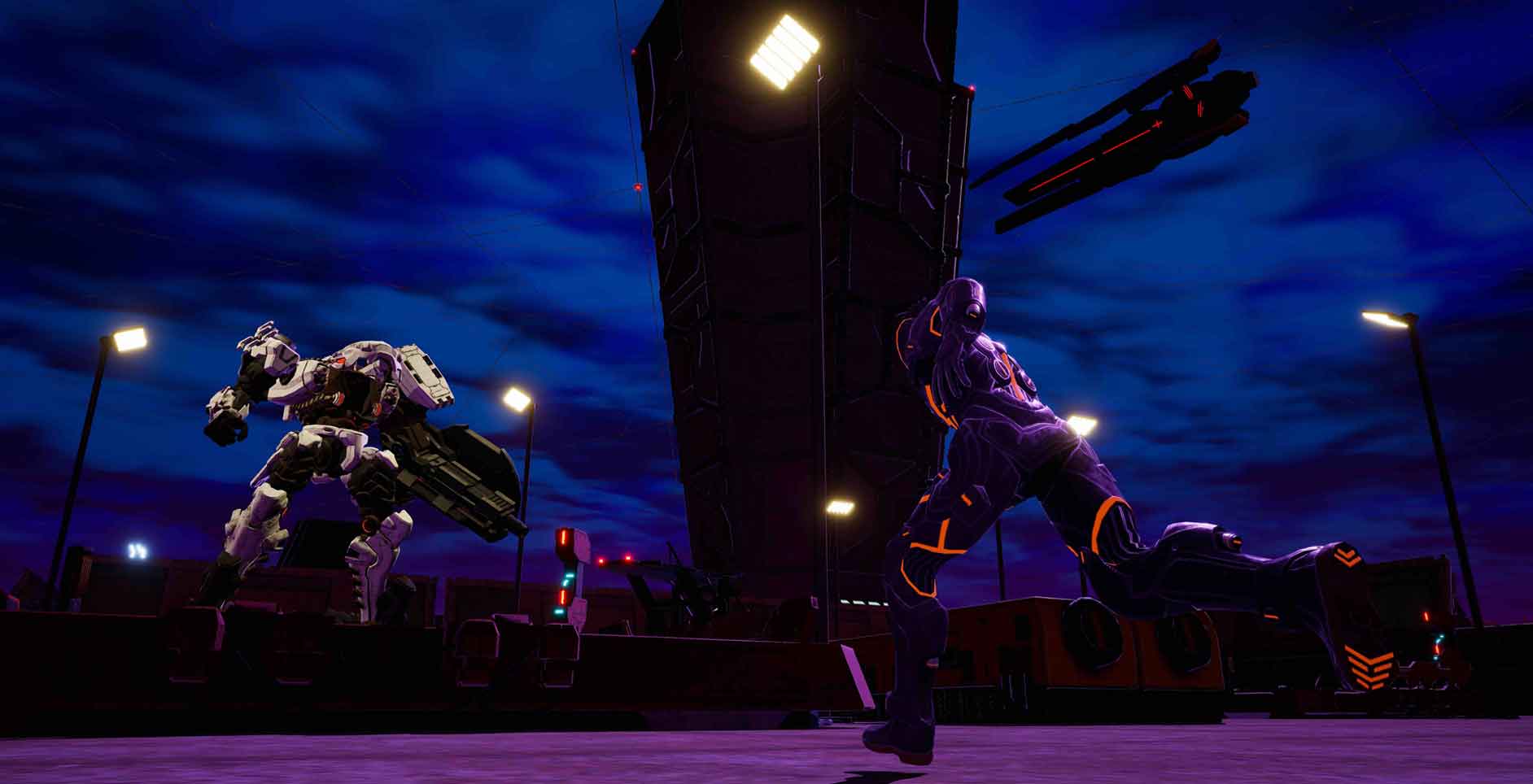
Q: I’d love to know about the enemy, the Arms of Immortal, and their objective besides being entirely against mankind and their goals. Is there more behind that?
As you can probably expect, I can’t give away too much about the story right now! But I will say, as you play through the game there will be some interesting twists and turns in the story.
What I can talk about right now is the background setting for Daemon X Machina’s story, which is that the moon has crashed down, with that catastrophe giving rise to new femto energy. Due to the femto energy the Arms of Immortal have been born, and the previously existing machines and artificial intelligence have turned against mankind.
In addition, the femto energy has also affected some human beings too, turning them almost superhuman. And that’s what the Outers are — they’re not just human beings, they’ve absorbed some of the femto energy and become more than just human. That’s where the name ‘outer’ comes from, and due to this they’ve been cast out or exiled from human society so they themselves are outcasts. So you have these almost superhuman Outers fighting against the AI, with both of those factions outcasts from humanity, and the way the story develops will be fairly dramatic and hopefully interesting and surprising.
Q: What’s it been like to work on the Nintendo Switch as opposed to other consoles?
Firstly, I really like Nintendo Switch — I think it’s a very interesting piece of hardware. In Daemon X Machina, obviously there’s a single player mode but there’s quite a strong multiplayer element too, and there’s a reason for that.
I think, these days, it’s become less common for people to actually get together in person, meet up, and play games together. And I think with Nintendo Switch, one of the great things about it is that you can really do both — you can play online, but it’s also a console that’s perfect to take with you and getting together with your friends, meeting up, and playing together.
We’re in an age now where it’s even more common for parents and children to play video games together and find ways to play video games together. Taking all of those factors into account, I really think Nintendo Switch is a cool console in terms of bringing people together, and giving you different options on how to play games with each other. There’s plenty of stuff in Daemon X Machina that will allow people to play the game together.
We want the game to be that enjoyable that even if you take it out, you play the game with friends, then go back home but you still want to play a little bit more — that’s the game that we’re hoping to create.
Q: What’s been your favourite thing about working on Daemon X Machina?
For me, I like drawing and I really like playing games. Working on Daemon X Machina with the development team we have — we have members of staff who can take those ideas I have about art and games, and improve them and say ‘let’s make them even better’. And so the team process of working on those ideas together, and aiming towards a finished product that can be the best it can possibly be for the end user, for the player — for me, that’s an amazing experience, and that is what I’ve really liked about working on this game.
Daemon X Machina launches on Nintendo Switch in early 2019.
